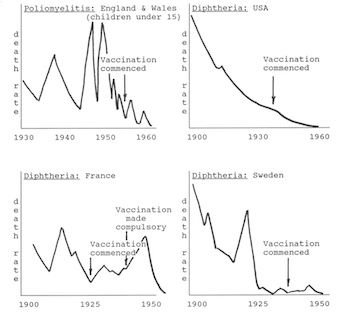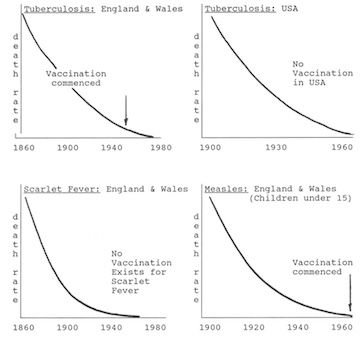The Historical Decline of Infectious Diseases
Sanitation or Vaccines?

Rene Dobos stated in his book, “Mirage of Health, 1959, by the time laboratory medicine became involved with medicine, humanitarians and social reformers of the nineteenth century had brought infectious disease under control through sanitation and hygiene programs, “When the tide is receding from the beach it is easy to have the illusion that one can empty the ocean by removing the water with a pail.”
“There was a continuous decline, equal in each sex, from 1937 onward. Vaccination [for whooping cough], beginning on a small scale in some places around 1948 and on a national scale in 1957, did not affect the rate of decline if it be assumed that one attack usually confers immunity, as in most major communicable diseases of childhood… With this pattern well established before 1957, there is no evidence that vaccination played a major role in the decline in incidence and mortality in the trend of events. – Gordon T. Stewart, 1977

from the 1850s public health initiatives building sanitary infrastructures, research and institutionalizing hygiene methods, improving nutrition, labor laws, and advances in scientific methodology came together and created a new matrix regarding how populations can maintain health for all people within crowded city populations and industrial centers. This happened within the span of 20 years!

Children stopped dying at a young age from diarrhea and common infectious diseases like smallpox and whooping cough. The Western countries had cleaned up its disease infested cities and industrial complexes and that work is what we see today. If you have read my previous articles the poor were driven from the commons through the industrialization of farming and moved into the cities that were not prepared for a huge influx of poor illiterate farmers. Throughout history it has been recorded infectious diseases like smallpox, typhus, and other diseases were called the poor man’s sickness.

The mass killers of humanity, infectious diseases start declining and began to fade away. By the end of the 1800s, smallpox lost its virulencey. Large populations of people stopped dying or becoming horribly ill from smallpox and it had totally disappeared from the USA. Smallpox was killing 1 in 5 people to 1 in 50 and continued on to 1 in 380. The disease still killed but had become very mild, to the point people couldn’t figure out what kind of disease they had when they became ill and developed rashes.

Around 1896 smallpox had become so mild in the South many people called the mild pox, chicken pox, the Cuban itch, elephant itch, Spanish measles, Japanese measles, bumps, impetigo, PortoRico scratches, Manila scab, Porto Reco itch, army itch, African itch, cedar itch, Manilia itch, bean, tch, Dhobie itch, Filipino itch, nigger itch, kangaroo itch, Hungarian itch, Italian itch, blood hives, eruptive grip, beanpox, waterpox, and swinepox.

It was common knowledge by those who lived outside of the rarefied circles of the bureaucracies of government regulators and manufactures of vaccines that sanitation had single handedly wiped smallpox off the map. Smallpox manufacturing was declining along with vaccination rates and yet small pox and other infectious diseases were on the decline.

“For forty years, corresponding roughly with the advent of the “sanitary era,” smallpox has gradually but steadily been leaving this country (England). For the past ten years the disease has ceased to have any appreciable effect upon our mortality statistics. For most of that period it has been entirely absent except for a few isolated outbreaks here and there. It is reasonable to believe that with the perfecting and more general adoption of modern methods of control and with improved sanitation (using the term in the widest sense) smallpox will be completely banished from this country as has been the case with plague, cholera, and typhus fever. Accompanying this decline in smallpox there has been a notable diminution during the past decade in the amount of infantile vaccination. This falling off in vaccination is steadily increasing and is becoming very widespread. Dr. Kilick Millard, “The Vaccination Question.”
What changed smallpox from a mass killer disease to something less lethal with very little fever and hardly any pain? The blisters were few and far between, maybe a dozen at the most. The red dots left by the eruptions faded within three weeks and left no scars. North Carolina in 1910 there were 3,875 cases with 8 deaths and by 1911 there were 3,294 cases without any deaths.
In the Journal of Infectious Diseases of 1913 there is a graph that shows in 1895 -1896, smallpox death had been declining for decades by 20 percent. By 1897 the death rate from smallpox was down to 6 percent and fell to 0.26 percent by 1908.


I remember catching chicken pox and measles back in the mid 1960s along with my sister we had a week off of school, a mini vacation. By the 1920s it was difficult to tell the difference between chicken pox and smallpox even in a clinical setting, chicken pox was recognized as a new form of small pox and most people were not vaccinated.
The medical community became concerned with the drop in vaccination by the general population. Their fear was that the mild form of smallpox may might revert back to it’s old habits of killing millions of people.

The medical community and manufacturers worried about their decline in patients and profits decided to complain against future pandemics that may never show up but you never know. It had been 20 years since large vaccination programs had vaccinated large populations (WWl) and any killer epidemics and spread through cities, counties, or countries. Most of the younger population hadn’t been vaccinated and the older population had not been revaccinated.
There were several outbreaks of small pox but it manifested it’s mild form around the 1920s-30s near the Mexican border towns, United States, Brazil, and most of Africa.
The Portuguese name of smallpox called Alastrim spread through many areas of the United States through 30 years, infecting many hundreds of people without changing into the more destructive from reported by American Health officers and epidemiologists.
There was a warning in 1921 that reminds me of the flu warnings we get were maybe a handful of people get sick and a few may die but nothing really happens. This horrible smallpox epidemic never showed up. It wasn’t because everyone was vaccinated because vaccine rates had dropped to almost nothing. The change of environment seems to have been the agent of change.
Smallpox had vanished from England and the Western world by 1946 without herd immunity from vaccination programs.

If you read standardized medical history books the decline of smallpox and other infectious diseases is attributed to vaccines. After reading the history of vaccines and the history of sanitary programs I have big doubts. Vaccination programs were never universally applied, while sanitation programs throughout the west were carried out transforming the cities and rural communities from filthy living conditions without clean water or healthy food to what we see today.

Maybe there are cycles of infectious diseases that burn their way through large densely packed populations like a fire burns its way through forests. Killing off the weaker trees and burning away infectious disease for the next generation of trees.

Smallpox infections fell to 50 percent by the end of the 1800s and completely vanished by 1948. From 1948 to 1963 smallpox vaccination continued resulting in an estimated 5,000 vaccine-related hospitalizations from rashes, secondary infections, and encephalitis. It wasn’t only smallpox disappearing but also other infectious diseases as well. The decline of all infectious diseases can be directly linked not to vaccination programs but sanitation, hygiene, and health programs.



 A link to My Blog
A link to My Blog